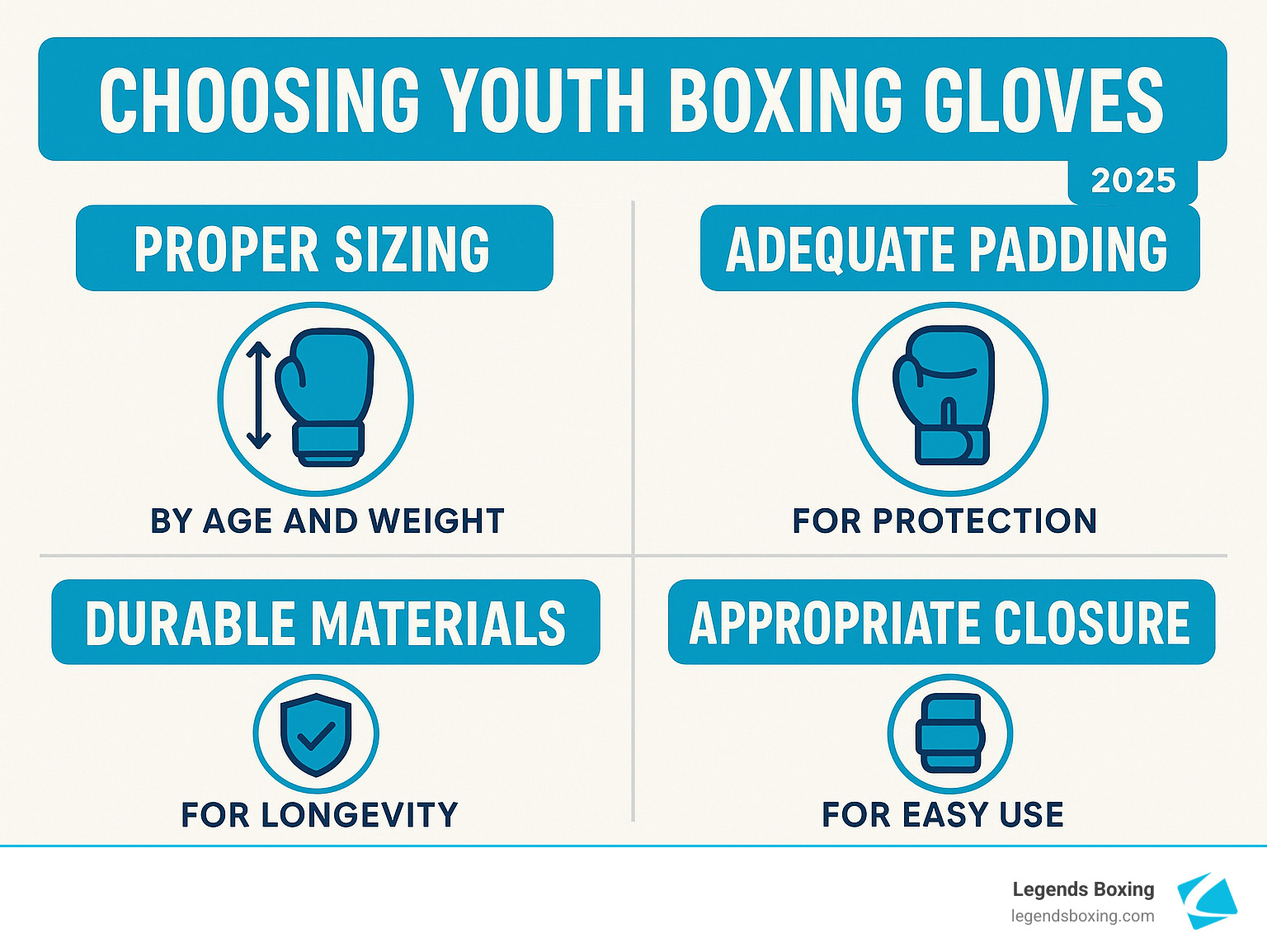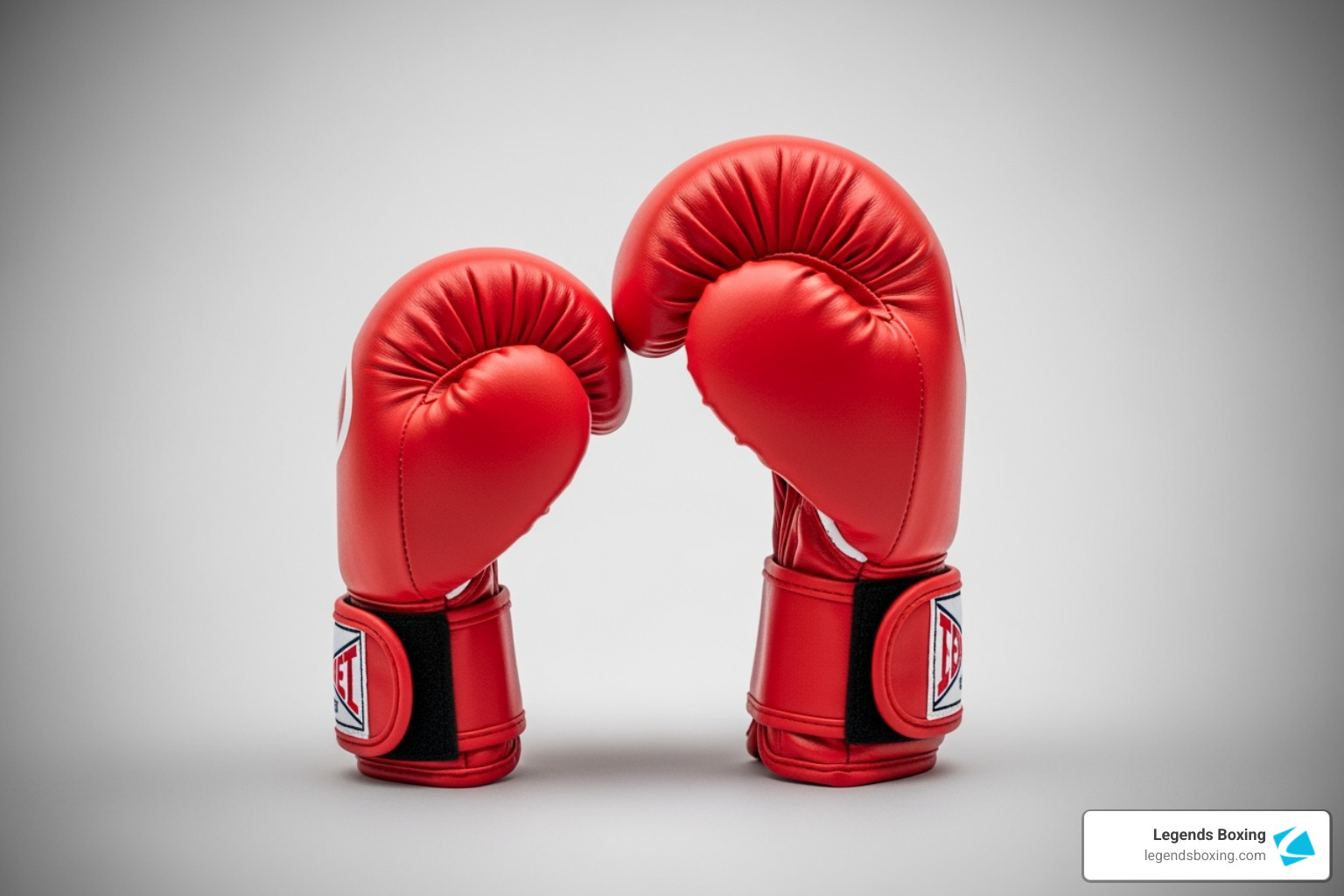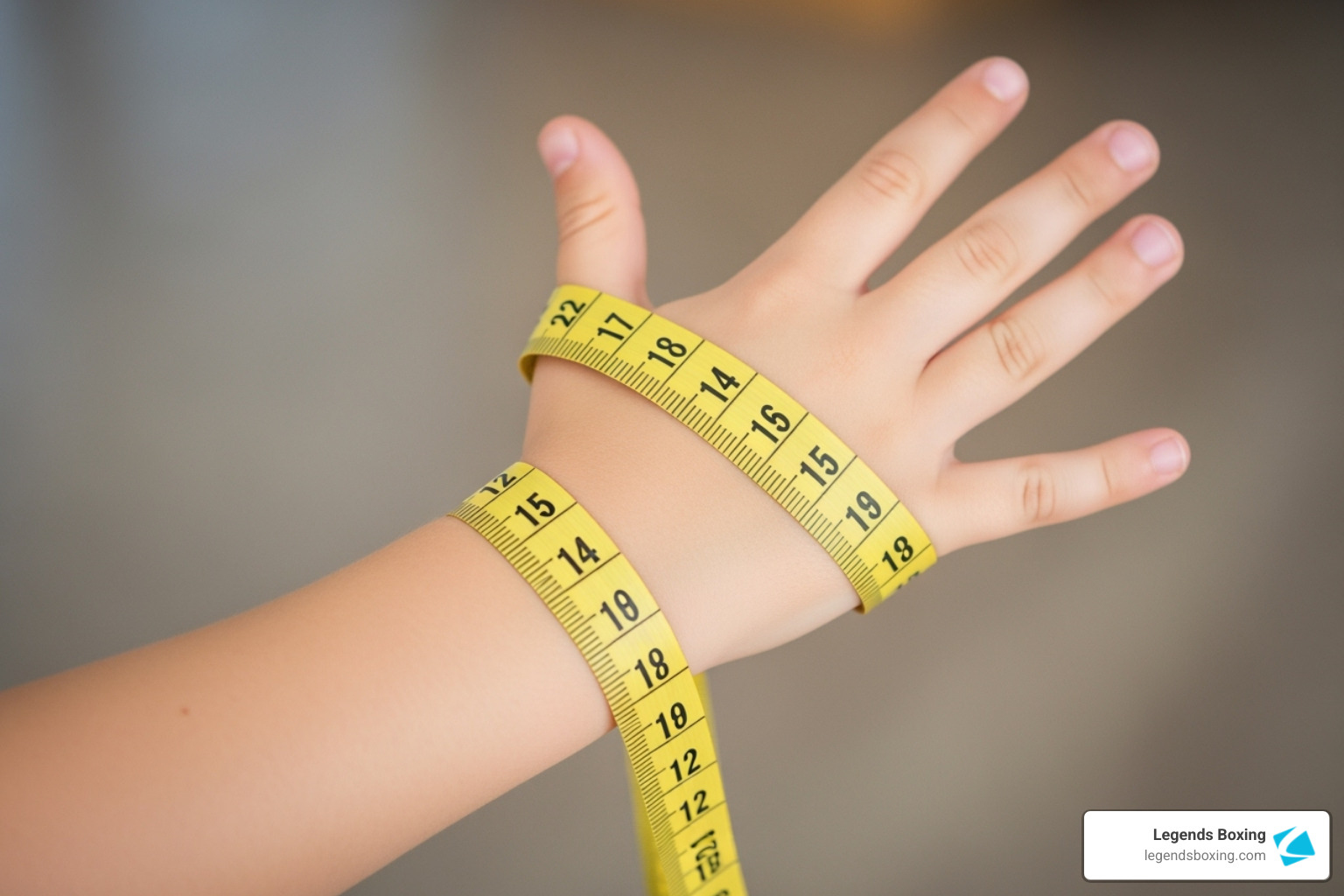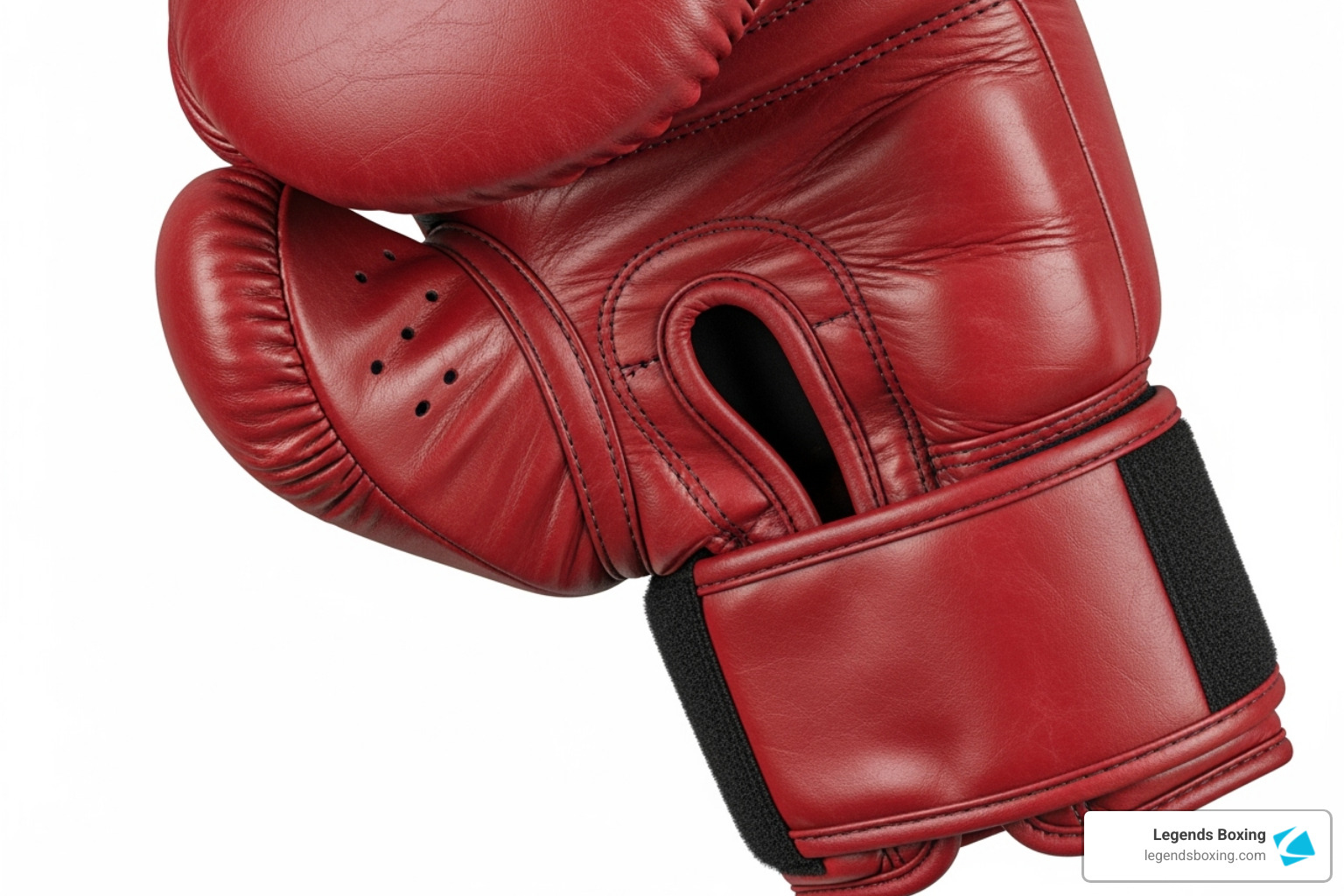Don't Get Gloved: A Parent's Guide to Youth Boxing Glove Sizes
Why Getting Youth Boxing Gloves Right Matters
Boxing gloves youth size selection is crucial for your child's safety, confidence, and skill development in the ring. Here's what you need to know:
Quick Youth Boxing Glove Size Guide:
- Ages 3-6: 4-6 oz gloves
- Ages 6-10: 6-8 oz gloves
- Ages 10-12+: 8-12 oz gloves
- Key factors: Child's weight, hand size, and training type
Every parent dreams of their children engaging in different activities that build character and confidence. Boxing is an excellent start to physical fitness for children, but success depends heavily on having the right gear from day one. As one industry expert notes, "the success or failure your child experiences right off will most likely determine if he or she sticks with the sport."
The weight of boxing gloves directly impacts how much padding protects your child's hands. Too light means insufficient protection. Too heavy creates bulky gloves that interfere with proper technique and hand placement. Getting this balance right isn't just about comfort - it's about injury prevention and building the foundation for a lifelong love of the sport.
I'm Robby Welch, National Head Coach at Legends Boxing with over two years of hands-on experience helping young athletes find the perfect boxing gloves youth size for their training needs. Through my work developing nationwide youth coaching programs, I've seen how proper glove selection transforms a child's boxing journey from frustrating to fantastic.

Boxing gloves youth size vocab explained:
Why the Right Fit Matters: The Benefits of Proper Youth Boxing Gloves
Picture this: your child steps into their first boxing class, gloves on, ready to learn. Those gloves? They're not just gear - they're their safety net, confidence builder, and skill developer all rolled into one.
Injury prevention is where it all starts. The right boxing gloves youth size acts like a protective shield for your child's developing hands and wrists. Think of proper gloves as tiny airbags that absorb impact with every punch. Without adequate hand protection, those small bones and joints take a beating they're simply not ready for.
Wrist support is equally crucial. Young wrists are still growing and need that extra stability to stay aligned during training. Well-fitted gloves keep everything in the right position, preventing those awkward twists that can sideline your young athlete.
Here's where things get really interesting: proper technique and punching form actually depend on having the right gloves. When gloves fit correctly, your child can make a proper fist inside them. Their hand sits exactly where it should, allowing them to throw punches with precision and control.
It's like learning to write with the right-sized pencil versus trying to grip a marker that's too thick. The wrong size makes everything harder and messier.
The confidence boost that comes from proper equipment is remarkable. When kids know their gear fits right and protects them well, they train with more enthusiasm. They're not worried about their gloves slipping or their hands hurting - they're focused on learning and having fun.
This confidence translates into long-term enjoyment of the sport. Kids who start with positive experiences tend to stick around longer, developing discipline, fitness, and self-esteem along the way. At Legends Boxing, we've seen how the right equipment sets the stage for a child's entire boxing journey. Check out our guide on what to expect in a youth class to see how proper preparation leads to success.
The Risks of Poorly-Fitting Gloves
Now let's talk about what happens when things go wrong. Oversized gloves are one of the biggest culprits we see. When gloves are too big, a child's hand floats around inside like a marble in a jar.
Bulky gloves create similar problems. They make it nearly impossible to form a proper fist, leading to incorrect hand placement and sloppy technique. Imagine trying to pick up a pencil while wearing oven mitts - that's what oversized boxing gloves feel like to a child.
Under-padded gloves are another serious concern. These bargain-basement gloves might look the part, but they offer little protection where it counts. The result? Knuckle damage that can range from painful bruising to more serious injuries.
Your child's bones are still developing. They need every bit of protection they can get.
Perhaps the most heartbreaking risk is discouragement. When kids struggle with ill-fitting equipment, they often blame themselves rather than the gear. They might think they're "bad at boxing" when really, their gloves are working against them.
We've seen too many promising young athletes give up simply because their first experience was frustrating due to poor equipment choices. The right gloves remove these barriers, letting kids focus on what really matters - learning, growing, and having a blast in the process.
Decoding Glove Sizes: How to Choose the Right Boxing Gloves Youth Size
Think of boxing gloves youth size like picking the perfect pair of shoes for your child - it's all about finding that sweet spot between protection and comfort. The secret lies in understanding glove weight, which is measured in ounces (Oz). Here's the thing: the heavier the glove, the more padding it packs inside. More padding means better protection, but it also means bulkier gloves that might feel awkward for little hands.
Youth gloves work differently than adult boxing gloves. While grown-up gloves focus heavily on the boxer's body weight, kids' gloves are designed with smaller hands and developing bodies in mind. They feature smaller hand compartments and often use softer, more forgiving foam that's gentler on young knuckles.
The trick is finding that perfect balance. A 6-ounce glove, for example, gives your child enough protection without feeling like they're wearing oven mitts. It's light enough for them to throw punches repeatedly during training, yet substantial enough to keep their hands safe and deliver proper technique.

Youth Boxing Glove Size Chart by Age and Weight
Choosing the right boxing gloves youth size doesn't have to feel overwhelming. I've put together this handy guide based on years of fitting young boxers with their perfect gloves:
| Age Range | Child's Approximate Weight (lbs) | Recommended Glove Size (Oz) | Notes |
|---|---|---|---|
| 3-6 years | Up to 60 lbs | 4-6 Oz | Lightweight, good protection for beginners and very young children. |
| 6-10 years | 60-90 lbs | 6-8 Oz | Most popular, multipurpose gloves suitable for general training and light sparring. |
| 10-12+ years | 90-120+ lbs | 8-10 Oz (or 10-12 Oz for serious training) | Allows for higher intensity training, suitable for those transitioning to more serious work. |
Most kids under 10 do fantastic with 6-8oz gloves - they're the goldilocks of youth boxing gloves. Once your child hits 12 years old and is getting serious about their training, 10-12 oz gloves become the go-to choice. These heavier gloves prepare them for more advanced techniques and higher-intensity workouts.
These are starting points, not hard rules. Your child's individual hand size and what type of training they're doing (hitting the heavy bag versus light pad work) can shift these recommendations. Every child grows at their own pace, and their gloves should match their unique needs.
Measuring for the Perfect Boxing Gloves Youth Size
Age charts are helpful, but nothing beats actually measuring your child's hands. Kids grow in spurts, and sometimes their hands are bigger or smaller than you'd expect for their age. Plus, getting the measurements right means fewer returns and exchanges!
Here's how to get an accurate measurement. First, if your child will be using hand wraps during training (which I highly recommend), have them put those on before measuring. This ensures the gloves will fit comfortably over the wraps without being too tight.
Next, take a flexible measuring tape and wrap it around the widest part of your child's hand, just below the knuckles. Don't include the thumb in this measurement. The tape should be snug but not tight - you want an accurate reading, not a tourniquet!

Once you have that measurement, you can compare it to specific brand sizing charts. Most quality glove manufacturers provide hand circumference recommendations alongside their ounce sizes.
The perfect fit feels snug but never painful. Your child's fingers should reach the top of the glove without being crammed in there. When they make a fist, there shouldn't be excessive wiggle room around their knuckles, but their thumb shouldn't feel jammed either. Think of it like a firm handshake - secure and confident, but not crushing.
If their hand slides around inside the glove when it's secured, it's too big. If they wince when putting it on or their thumb feels squished, it's too small. We're aiming for that "just right" feeling that keeps them comfortable and protected throughout their entire training session.
Beyond the Size Tag: Key Features to Look For
Getting the perfect boxing gloves youth size is just the beginning of your journey. Think of it like buying a car - you wouldn't just look at the size, right? You'd want to know about safety features, comfort, and how long it'll last. The same goes for boxing gloves!
Once you've nailed down the right size, several other features make the difference between a glove that truly protects your child and one that just looks the part. We're talking about padding quality, wrist support, closure systems, and materials. These details might seem small, but they're what separate a great glove from a disappointing one.

Padding and Protection
The foam core is where the magic happens - it's literally what stands between your child's knuckles and whatever they're hitting. For youth gloves, we want multi-layered foam that's dense enough to absorb impact but soft enough to be comfortable. Think of it as a tiny airbag system for their hands.
Here's something many parents don't realize: kids' bones are still developing, which means they need more protection than adults, not less. That's why knuckle protection is so crucial. Quality youth gloves distribute the force of impact across the entire hand, rather than letting it concentrate on specific knuckles.
The thumb attachment is another safety feature that's absolutely non-negotiable. You'll want gloves with a "tied thumb" design, where the thumb is sewn to the main body. This prevents those painful thumb injuries that can happen when a thumb gets bent the wrong way during training.
Want to learn more boxing terminology? Check out this helpful Boxing Glossary to get familiar with the sport's language.
Closure Systems: Velcro
For youth boxing gloves, Velcro (also called hook and loop) closures are the clear winner. Why? Because they make life so much easier for everyone involved!
The ease of use factor can't be overstated. Kids love being independent, and Velcro straps let them put on and take off their gloves without constantly asking for help. Compare that to lace-up gloves, which require adult assistance every single time.
But convenience isn't the only benefit. A good Velcro strap provides excellent wrist support, wrapping around to create a stable, protective barrier. This is crucial for preventing wrist injuries during training. The adjustability is another bonus - you can fine-tune the fit as your child grows or when they're wearing hand wraps.
Materials: Leather vs. Synthetic
The material choice often comes down to balancing durability, cost, and practicality. Both genuine leather and synthetic leather options have their place in youth boxing.
Genuine leather gloves are the premium choice. They're incredibly durable and can last for years with proper care. Over time, they actually mold to your child's hand shape, creating a custom fit. The main drawback? They come with a higher price tag.
Synthetic leather (made from vinyl or PU materials) offers excellent value for youth boxing. While they won't last as long as genuine leather, high-quality synthetic options can handle regular training sessions just fine. They're also easier to clean and maintain - a real advantage when you're dealing with sweaty kid gear!
For beginners or children who might outgrow their gloves quickly, synthetic leather makes perfect sense. It provides good protection without breaking the bank. Just avoid the very cheap canvas or neoprene options, which typically only last a few months of regular use.
The key is choosing from reputable brands, regardless of whether you go leather or synthetic. Quality construction matters more than the specific material when it comes to keeping your young boxer safe and comfortable.
Glove Types and Glove Care
Just like choosing between sneakers and dress shoes, different boxing activities call for different types of gloves. Your young boxer will likely encounter training gloves, sparring gloves, and sometimes bag gloves during their boxing journey. Understanding these differences helps you make smart choices about what gear your child actually needs.
Think of it this way: you wouldn't send your kid to soccer practice in flip-flops, right? The same logic applies to boxing gloves. Each type serves a specific purpose and keeps your child safe while they're learning.
Ready to see these gloves in action? You can find a gym near you to get started and check out our facilities firsthand!
Training vs. Sparring Gloves for Kids
All-purpose training gloves are your go-to choice for most young boxers. These versatile gloves handle everything from heavy bag work to pad work with their coach. They strike the perfect balance between protecting your child's hands and allowing them to develop proper technique. Most of the boxing gloves youth size options we've discussed fall into this category.
When your child is working the heavy bag, these gloves absorb the impact while helping them maintain correct hand positioning. They're built for repetitive punching and can handle the daily grind of training sessions.
Sparring gloves enter the picture when your child advances to supervised partner drills. These gloves pack extra padding - think of them as the protective big brother of training gloves. A child who normally wears 8oz training gloves might use 10oz sparring gloves for partner work.
Here's the key difference: that extra padding isn't just for your child's protection - it's primarily for partner safety. Nobody wants to accidentally hurt their training buddy! The additional cushioning reduces impact during controlled sparring sessions.
Many serious young boxers end up with two pairs of gloves as they progress. One stays dedicated to bag and pad work, while the sparring gloves remain fresh for partner training. Always check with your child's coach before buying sparring gloves - they'll know exactly what's appropriate for your child's skill level.
How to Clean and Maintain Youth Boxing Gloves
Let's be honest - boxing gloves can get pretty funky. Between the sweat, the intensity of training, and those growing hands, proper care becomes essential for both hygiene and your wallet.
Wiping down after use should become as automatic as brushing teeth. Grab a damp cloth with warm water and clean both inside and outside the gloves immediately after training. A mild anti-bacterial spray works wonders too. This simple step stops sweat and bacteria from setting up permanent residence in the gloves.
Air drying is absolutely crucial. Never, ever stuff sweaty gloves into a gym bag and forget about them - trust me, you'll regret it later! Open those gloves wide and let them breathe in a well-ventilated area. Paper towels tucked inside help absorb extra moisture. Just keep them away from direct sunlight or heat sources that might crack the material.
Glove deodorizers or cedar chips work like magic for keeping things fresh. Pop them inside when the gloves aren't in use, and they'll absorb moisture while fighting off odors. Your car (and everyone in it) will thank you.
Preventing bacteria starts with clean hands. Make sure your child washes up before and after training. Hand wraps act like a protective barrier, soaking up sweat before it reaches the glove lining - another great reason to use them consistently.
Storing properly means finding a cool, dry spot once everything's completely dry. Hot cars and damp basements are glove killers, so choose wisely.
Checking for wear and tear should happen regularly. Look for thinning padding, cracked material, or loose stitching. When padding breaks down, protection disappears - and that's when injuries happen. If the gloves show serious deterioration, it's time for a replacement pair.
Taking care of your child's boxing gloves youth size isn't just about making them last longer (though your budget will appreciate that). It's about keeping training sessions comfortable, hygienic, and safe so your young boxer can focus on what really matters - having fun and getting stronger.
Frequently Asked Questions about Youth Boxing Gloves
As parents explore youth boxing, we hear the same thoughtful questions over and over. Let me address the most common concerns about boxing gloves youth size and safety that come up when families are getting started.
What's the most important factor when choosing youth boxing gloves?
Safety is absolutely the top priority when selecting youth boxing gloves, and that safety comes from getting the proper fit right. Think of it this way - even the most expensive gloves in the world won't protect your child if they don't fit correctly.
A proper fit means your child can make a secure fist inside the glove without their hand sliding around. The glove should feel snug but not uncomfortably tight. Adequate padding works hand-in-hand with proper fit to absorb impact and protect those developing bones and joints.
Don't overlook wrist support either. A good Velcro closure system that wraps securely around the wrist prevents hyperextension injuries that can sideline young athletes. The success or failure your child experiences in those first few sessions often determines whether they'll stick with boxing long-term.
Do my kids need hand wraps under their gloves?
Yes, hand wraps are essential! I can't stress this enough - hand wraps provide crucial protection that gloves alone simply can't offer.
Here's what hand wraps do for your young boxer: They create added protection by giving an extra layer of cushioning for knuckles and the small bones in developing hands. The wrist stability they provide keeps everything aligned properly during punches, preventing those painful wrist sprains that can happen when joints bend the wrong way.
Hand wraps also help with knuckle support, keeping everything tightly packed together so bones don't shift during impact. From a practical standpoint, they help create a proper fit inside the glove and absorb sweat, which keeps the gloves fresher longer and prevents that gym bag smell we all want to avoid.
How often should I replace my child's boxing gloves?
With regular training, plan on replacing your child's boxing gloves youth size every 6-9 months. Kids are hard on their gear, and those gloves take quite a beating during training sessions!
Watch for these telltale signs it's replacement time: Worn-out padding that feels flat or lumpy means the gloves can't absorb impact properly anymore. Any visible damage like cracked material, loose stitching, or Velcro that won't stick securely makes the gloves unsafe to use.
The most common reason for replacement? Your child outgrows them! Kids' hands grow faster than you might expect. If your child complains that their gloves feel tight or their fingers are getting jammed, it's definitely time to size up.
Replacing gloves regularly isn't just about comfort - it's about maintaining the level of protection your young athlete needs to train safely and confidently.
Conclusion
Finding the perfect boxing gloves youth size isn't just about picking any gloves off the shelf - it's about giving your child the foundation they need to fall in love with boxing while staying safe and building confidence. Throughout this guide, we've covered how the right fit protects developing hands, supports proper technique, and creates those positive early experiences that keep kids coming back to the gym.
Safety always comes first. A properly fitted glove with adequate padding and solid wrist support means your child can focus on learning jabs and hooks instead of worrying about sore knuckles or wobbly wrists. When the gear feels right, everything else follows naturally - better form, more confidence, and genuine excitement about training.
The journey from measuring tiny hands to watching your child throw their first confident combination is incredibly rewarding. Whether you're starting with 4-ounce gloves for your preschooler or stepping up to 10-ounce gloves for your pre-teen, the right boxing gloves youth size makes all the difference in their experience.
At Legends Boxing, we've seen countless young athletes find their potential when they have the right equipment and supportive coaching. There's nothing quite like watching a shy kid transform into a confident young boxer, throwing punches with perfect form and a huge smile.
Ready to see your child's boxing journey begin? We'd love to help them find their perfect gloves and find what they're capable of. Book a free workout for your child at one of our Legends Boxing locations, and let's get those gloves on and start throwing some punches together!






